Case on a 20' flatrack
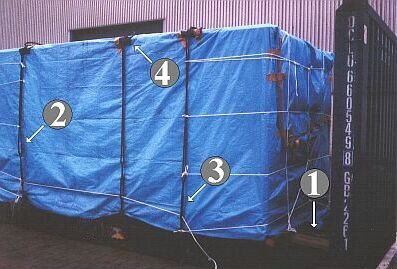 |
The wooden bracing at (1) consists of two lengthwise and crosswise beams, attached directly to the floor of the flatrack. Since the case itself is standing on transverse skids, the effective height of the bracing lumber is too small at the case end wall. It is uneconomic to secure the case by means of tie-down lashings of 16 mm diameter steel wire ropes and turnbuckles (2) and (3). It is a good idea to use edge protectors made from hard-wearing segments of automobile tires (4) and the weather protection with which the case is provided is definitely a positive feature. However, a few more meters of binder twine would not have done any harm. The adhesive strips used are water-resistant.
The small effective height of the squared lumber is shown here.
 |
|
| Inadequate effective bracing height |
The problem could have been eliminated by using two more crosspieces (2).
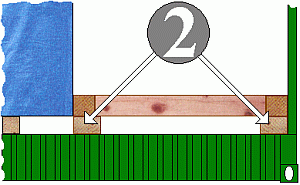 |
It would have been somewhat cheaper to use two boards (3) nailed together to form steps, between which the two lengthwise pieces are inserted.
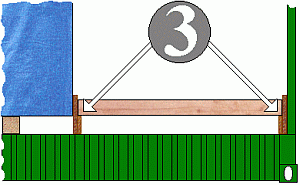 |
It is a waste of material to use tie-down lashings made from steel wire ropes with a diameter of 16 mm together with turnbuckles, since, on the one hand, the maximum securing load of these materials is higher than that of the lashing points and on the other hand the method of arranging them requires an unnecessarily large amount of wire.
With normal deflection radii, 16 mm diameter steel wire ropes could be used to produce lashings with a maximum securing load of 10,240 daN. However, the lashing points on the flatrack have a maximum securing load of only 3,000 daN. Approx. 12 m of steel wire rope, two shackles, one turnbuckle and four wire clips are used per tie-down lashing.
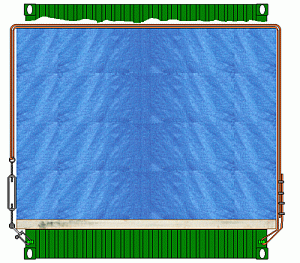 |
|
| Basic diagram showing wasteful tie-down lashing |
Another disadvantage is that, when the case is secured, all the tensioning elements are located on one side and the pretension is thus considerably higher on that side than on the opposite side.
Since the flatrack does not have stanchion pockets, it is out of the question to use specially shaped stanchions for transverse securing. From the point of view of labor and materials, it would have paid off to prepare "case restraint shoes" for transverse securing purposes.
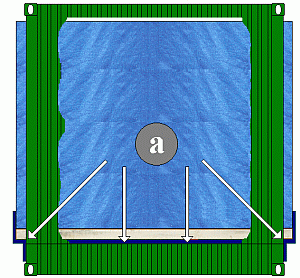 |
|
| Lateral securing using case restraint shoes |
With two such case restraint shoes (a), a 100% tight fit could have been produced for lateral securing.
Efficient securing could have been produced in this way:
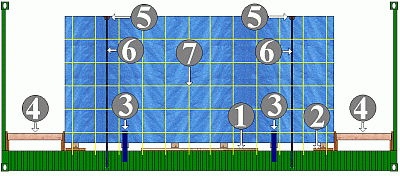 |
|
| Securing the overwidth case on a 20' flatrack |
Boards of the same thickness as the case restraint shoes are positioned lengthwise (1) or crosswise (2) beneath the transverse members of the case bottom in such a way that the case cannot sag at the bottom. Two case restraint shoes (3) are positioned in such a way that the case can be placed on them with two of the transverse skids. The gaps remaining relative to the front end wall of the flatrack are braced with boards or planks and squared lumber (4). Edge protectors of a material with good recovery (5) are put in place and two steel strapping tie-down lashings (6) are fitted. The tarpaulin provided to protect the case from the weather is fixed securely with tightened and knotted close-meshed binder twine or the like, such as 4 mm thick PE or PP tape.